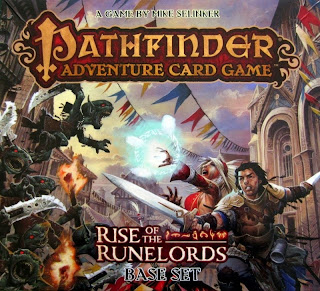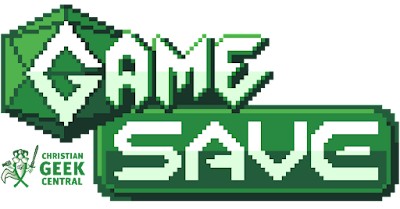Pathfinder Adventure Card Game (Board Game Review)
Review by Paeter Frandsen
I'm a big
fan of the "dungeon crawl" genre of board games, especially those
that are cooperative or feature a "game master" player. However, In
the last few years I've been continually disappointed in the options for games
of this kind. So when I heard that Paizo Publishing was planning to create a
card game that attempted to distill the Pathfinder RPG experience into a
shorter, lighter, card-based experience, I was intensely interested in seeing
the result. Pathfinder Adventure Card Game: Rise Of The Runelords is a
mouthful. But that may be appropriate, as there is a lot going on inside this
game box.
Rise Of The Runelords is the name of an "Adventure Path," one of a
series of adventures that will be released as expansions over the coming year. Each
Adventure Path is itself composed of multiple "scenarios," which each
take 90 minutes or so to play. Rise Of The Runelords comes with several
introductory scenarios, as well as the first Adventure in the series, making
for a total of 8 different scenarios in the box. If that doesn't sound like much,
I can assure you that although I have played the first scenario 4 times, using
the same character each time, the randomized elements and other variables made
each experience unique. I never once felt bored or able to predict what would
happen next.
This is a fully cooperative game in which 1-4 players each assume the role of one of the seven available characters. The characters that come with the basic game conform to classic fantasy RPG character types and include Fighter, Thief, Wizard, Sorcerer, Bard, Cleric, and Ranger. Players work together against the game to find and defeat a chief villain and his or her henchman. They explore different locations represented by decks of cards, fight monsters, avoid traps, and acquire loot with which they can upgrade their characters between scenarios before continuing on.
Each character is represented by a deck of about 15 cards. The cards in a character deck detail that character's abilities, equipment, and vitality. Each player also has a character card containing a list of stats and abilities for that character. This card sits in front of them throughout the game and is referred to when determining which dice must be rolled for a given situation.
At the start of each turn, players draw or discard until they reach the correct hand size for their character. During their turn, they move their character to one of several available locations (represented by a deck of cards). At that location they typically explore by revealing the top card and interacting with it. This card may be a monster, some loot, a trap, etc. The player than rolls a specific type of die (d4, d6, d8, d10 or d12) as indicated by the stats listed on their character card, in an attempt to meet the location card’s challenge.
Acquiring an ancient tome at the temple may require a successful "Knowledge check," while defeating a monster usually requires a successful combat check against the monster's listed combat rating. Failed rolls in combat result in damage to the hero, who must then discard cards from their hand or deck. If a player is ever required to draw cards from their deck but has no cards left to draw, they are dead and out of the game.
These checks can be modified by playing cards from your hand. There are typically three ways to play a card, each granting increasing potency to its effects on the game. You may either "reveal" a card (granting a basic bonus to your check), "recharge" a card (placing the card on the bottom of your deck and gaining a more powerful bonus), or "discard" a card (granting the most powerful effect). These choices cleverly simulate expending energy, since the most powerful effects actually deplete your own health (represented by the cards in your deck).
In addition to the danger of running out of cards in your deck, a clock is ticking in the form of of a special deck of cards that is drawn from at the start of each turn. If this deck ever runs out, all of the players lose, so economy of turns is vital to success.
Usually, the players win the game when they find and defeat the villain for the scenario. However, this can be tricky, since villains can only be truly defeated if they are unable to escape to another location. For this reason, in addition to looking for the villain, players attempt to "close" the locations they visit. A player may attempt to close a location either after defeating one of the villain's henchman or when there are no cards remaining in a location. Each location requires a different kind of check to be passed or feat to be accomplished in order to close it. When a villain is defeated in combat and has no locations to escape to, the players win the scenario. If all heroes die or the "timer deck" runs out, the heroes lose.
Components for the game are solid but a slightly mixed bag.
A single set of plain blue dice is included, but you'll quickly want to invest in multiple sets of dice for both aesthetic and practical reasons. The blue dice that come with the game are frankly cheap-looking and ugly (why not solid black or white instead, Paizo?) and many checks require multiples of the same kind of die to be rolled. (I have three matching sets already and I'm currently feeling the need for at least one more 4-sided die.)
The art on the cards looks great. The style is serious with a dark edge from time to time. While not graphic or especially disturbing, this game definitely looks visually designed for adult fans of no-nonsense fantasy.
The layout of the game makes things pretty easy to understand. Although you have many stats and abilities associated with your character, you are not required to consult your stats unless the situation calls for it. You simply encounter a card, see which stat it asks you to check, look at your character card, and then roll the appropriate dice (modified by any cards you wish to play). This approach allows for rich, thematic complexity without the burden of mechanical complexity.
Although many cards you encounter will be bad (monsters, traps, etc.) many others will be good. Weapons, items, spells, and even allies can be acquired during the game if you pass the appropriate check (an arcane check to learn a new spell, a charisma check to recruit a new ally, etc.). These cards then go directly into your hand. In addition, there is usually a reward given after completing each scenario, such as adding cards to your deck or permanently increasing a skill or attribute on your character card. (The rules suggest lightly marking your character cards in pencil, but Paizo and boardgamegeek.com also provide free printable character sheets for this purpose.)
Each character is limited to having a certain number of cards and card types in their deck at the start of each game, so between games, players take all the cards from their hand, deck, and discard pile and decide which cards they will keep and which cards they will put back in the game box. At this time players may also trade cards with each other. This aspect of the game is extremely satisfying and scratches the itch I have for looting and upgrading, as well as my occasional itch for deck-building.
This brings me to one of the greatest strengths of this game. In almost every case, the rules of the game bring out the theme. Despite using several non-dungeon locations, it feels very much like a traditional dungeon crawl, but without the need for a game master. The roleplaying elements are absent, but many of the thematic mechanics of roleplaying are intact. I feel like a fool when I fail my wisdom check and become distracted by the shopkeeper's daughter. I feel like a master wizard when my arcane skill gives me an advantage against a powerful sorcerer. I can imagine the magical duel in my mind. There is potential here for not just great gameplay, but great stories that players will remember.
The plot of the game itself is less interesting and only expressed in flavor text here and there, which is easy to skip over unless you are purposeful about reading it out loud. The character portrayal element of paper and pencil RPGs has not transferred to this game, which will delight some who would rather just work the strategy and tactics, and disappoint others who love to actually roleplay.
One element of the game that may be a downside for some players (myself included) is the punishing nature of death. When a character dies, that player may no longer play in the current game. In my experience, death in the game is not very common and can usually be avoided by conservative play. However, being too conservative will result in losing the game to the time constraints, so players are required to be aggressive, and to keep death fairly close at hand, in order to win.
I greatly dislike the potential for a player to be ejected from a game before it is finished. On a social level, this removes a person from the primary social experience. On a game level, it essentially says, "You can't have fun anymore. Sit there and wait while others continue having fun." This aspect of punishment for death may add intensity to the game experience, but it seems like a cheap way to do it.
What I dislike even more is the fact that death in this game is permanent. Any equipment or abilities you have gained over the course of multiple adventures is lost. You must start the next game with a brand new character, who may only use basic starting equipment and has none of the attribute bonuses earned by other characters in previous scenarios. In one tutorial video for the game, the creators explained that a player may play several solo scenarios to "catch up" to the other players’ level, but this strikes me as a lame solution. Instead, I've made the house rule that characters who die may start the next game with only basic equipment, but with any endgame rewards gained from previous scenarios. This is an easy fix, and one I'm surprised was not even mentioned as an option in the rulebook.
The Pathfinder Adventure Card Game is highly unlikely to provoke any thought or conversation regarding spiritual matters, unless you are playing with someone who is sensitive to the themes of fantasy and magic in general. There are one or two brief and vague references to "sin magic" being employed by the enemy, which made me curious about the use of this word in the Pathfinder RPG setting. Unfortunately, because the story and setting of the adventure card game do not directly engage the players, even this somewhat intriguing reference was quickly forgotten.
If you're looking for a mechanically simple yet strategic and thematically rich dungeon crawl experience (and don't mind the absence of miniatures and a board to move around on), I'd highly recommend the Pathfinder Adventure Card Game: Rise Of The Runelords.
Recommended for ages 13+
Quality: 9.0/10.0
Relevance: 5.0/10.0





Comments
Post a Comment